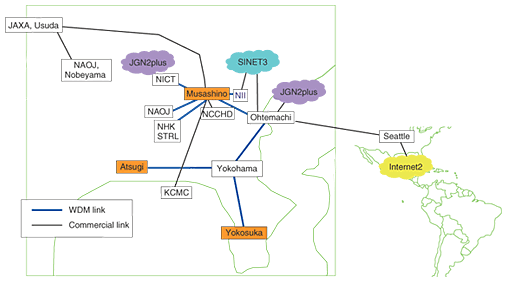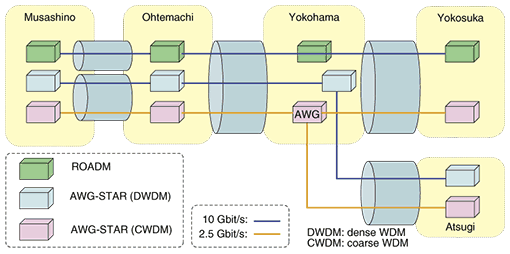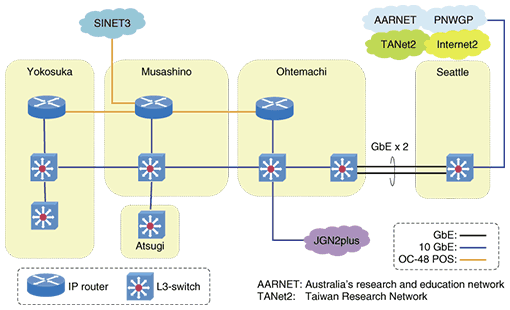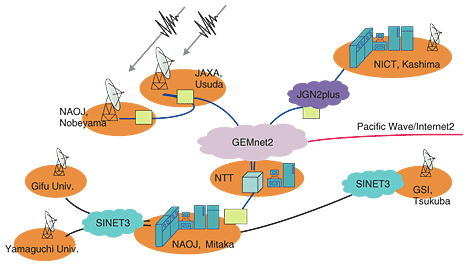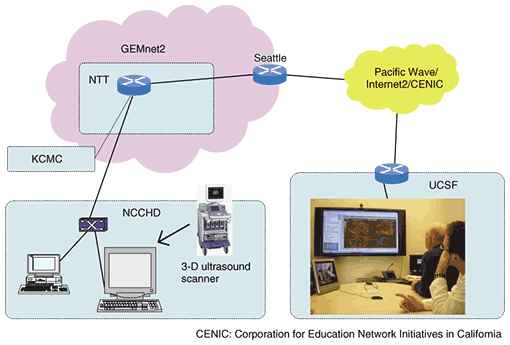 |
|||||||||||||||||||||||||
|
|
|||||||||||||||||||||||||
|
Special Feature: GEMnet2 Vol. 7, No. 2, pp. 17–21, Feb. 2009. https://doi.org/10.53829/ntr200902sf3 GEMnet2: Overview and ActivityAbstractA network testbed called GEMnet2 (Global Enhanced Multifunctional Network) has been constructed and is being operated to test communication technologies being developed in NTT Laboratories. This article describes its configuration, transmission technologies, connectivity to other research and education (R&E) networks, and recent research activities conducted using GEMnet2.
1. IntroductionGEMnet2 (Global Enhanced Multifunctional Network) is a network testbed being researched and developed at NTT Laboratories to test every aspect of communication technologies in the physical, network, and application layers [1]. It provides very large bandwidth by using NTT’s wavelength division multiplexing (WDM) transmission technologies and accommodates very fast applications. It has both domestic and international connections with other research institutes inside and outside Japan through research and educational (R&E) networks such as SINET3 (Science Information Network), JGN2plus (Japan Gigabit Network), and Internet2. It is also used for science, education, and medical experiments in collaboration with other research institutes and universities all over the world. A wide range of research on network, middleware, and application technology is performed throughout NTT Laboratories using GEMnet2’s optical transmission technology. 2. Configuration of GEMnet22.1 Node locationsThe locations of nodes in GEMnet2 are shown in Fig. 1. GEMnet2 connects three research and development (R&D) centers at Musashino, Yokosuka, and Atsugi using optical fiber cable for WDM transmission systems via the NTT Ohtemachi and Yokohama buildings. GEMnet2 occupies collocation space at Pacificwave Northwest Gigapop (PNWGP) in Seattle, USA, and has an international link with Ohtemachi.
GEMnet2 provides excellent connectivity to other institutes outside NTT Laboratories to enhance collaborative research between NTT Laboratories and other research institutes or universities, as shown in Fig. 1. It has a direct connection with the National Institute of Informatics (NII), National Institute of Information and Communication Technology (NICT), National Astronomical Observatory (NAOJ), Japan Aerospace Exploration Agency (JAXA), Nippon Hoso Kyokai Science & Technical Research Laboratories (NHK STRL), National Center for Children’s Medical Health and Development (NCCHD), and Kanagawa Children’s Medical Center (KCMC). Interconnections with JGN2plus, SINET3, Internet2 enable NTT researchers to collaborate with university students and engineers at research institutes. 2.2 Network configurationWDM links between R&D centers are shown in Fig. 2. WDM transmission systems, such as AWG-STAR (AWG: arrayed-waveguide grating) and ROADM (reconfigurable optical add-drop multiplexer) systems that have been developed in NTT Laboratories, were installed at each node and connected to optical fibers through NTT buildings. Since each wavelength path has a transmission capacity of 2.5 or 10 Gbit/s, a total transmission capacity of several tens of gigabits per second is provided between each pair of nodes.
These WDM resources are being provided in the appropriate layer of the connections in GEMnet2—lambda (wavelength) layer, data layer (layer-2 (L2)), or network layer (layer-3 (L3))—according to experimental convenience. The L2 and L3 connections between R&D centers are shown in Fig. 3. Each center is connected by a 2.488-Gbit/s packet-over-SONET/SDH (POS) link (OC-48) and a 10-GbE (10 Gigabit Ethernet) link in a ladder configuration (SONET: synchronous optical network, SDH: synchronous digital hierarchy).
There is a POS link from the Musashino R&D center to NII, and GEMnet2 is connected to SINET3 by a POS link at NII and this connection is used for research collaborations with universities in Japan. This connection is used for research collaborations with universities in Japan. In the NTT Ohtemachi building, GEMnet2 is connected to JGN2plus by a 10-GbE link, which is used for transmission experiments involving large data streams such as 4K cinema or uncompressed high-definition video signals. For international connection, two GbE links were established and a link aggregation system was installed between Ohtemachi and Seattle. 3. Research activities3.1 OverviewUsing GEMnet2, various experiments have been executed on the physical, network, and application layers. Advanced WDM transmission technology systems, such as AWG-STAR [2] and ROADM, have been installed to verify operating stability and provide very large bandwidth between laboratories and the flexibility to change the logical configuration. Various field trials of new network technologies have been performed, such as the interoperability test of the Multiservice Forum [3], development of a management and signaling technique for a GMPLS-enabled network (GMPLS: generalized multiprotocol label switching) [4], and a connectivity test of an IPv6 (Internet protocol version 6) network. In the case of high-speed applications, transmission technologies for several kinds of high-definition video streams have been developed using GEMnet2, such as an uncompressed HDTV (high-definition television) stream using the Internet Video Studio System for HDTV production (i-Visto) [5], digital cinema data distribution based on JPEG 2000 technology (JPEG: Joint Photographic Experts Group), 4K video IP stream transmission [6], and 8K or SHV (super high-vision) image transportation using a video codec system [7]. GEMnet2 is also used for developing scientific and medical applications: electrical very long baseline interferometry (e-VLBI) for radio astronomy and remote diagnosis for fetus treatment. 3.2 e-VLBI observationsIn 1996, NTT Laboratories and NAOJ started e-VLBI observations using a high-speed network [8], [9]. Data transfer systems using asynchronous transfer mode technology and IP have been developed and connected to R&E networks. The recently established observation system configuration in Japan that is centered on NAOJ, NICT, JAXA, and NTT Laboratories is shown in Fig. 4. An e-VLBI observation network connects the main radio telescopes throughout the whole country through mutual connections among GEMnet2, SINET3, and JGN2plus. Radio telescopes in NAOJ Nobeyama, JAXA Usuda, Gifu University, NICT Kashima, GSI (Geographical Survey Institute) Tsukuba, and Yamaguchi University are connected to a correlator in NAOJ Mitaka. In some cases, GEMnet2’s international connections are utilized to connect to telescopes outside Japan, such as the one at the Massachusetts Institute of Technology in the USA.
Nowadays, e-VLBI with R&E networks has become indispensable to radio astronomical observations all over the world. 3.3 Remote medical treatmentSurgical operations on fetuses that have abnormalities in their internal organs are an advanced type of medical treatment. Such prenatal treatment enables a return to normal growth. NCCHD, KCMC, and NTT have started joint research with the University of California at San Francisco (UCSF) to develop technology for remote diagnosis and treatment using high-speed network technology [10], [11]. This experimental system’s configuration is shown in Fig. 5. NCCHD and KCMC are connected to NTT Musashino R&D center by a commercial FTTH (fiber-to-the-home) service and to UCSF through GEMnet2 and other R&E networks in the USA. High-quality teleconferencing systems using MPEG-2 codecs and three-dimensional ultrasound image viewers are set up at each base (MPEG: Moving Picture Experts Group). One special disease was diagnosed and analyzed by three doctors at the same time across the Pacific Ocean. This discussion gave doctors a unique opportunity to improve their knowledge. They also agreed that this system is effective for the distribution of new medical treatments. Since doctors have agreed about the effectiveness of this trial, next-stage work will now be performed.
4. SummaryThe configuration and activity of GEMnet2 were described. GEMnet2 has become indispensable for testing communication technologies developed in NTT Laboratories and for collaborative research with other research institutes. References
|
|||||||||||||||||||||||||








